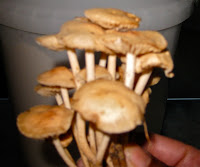Right now Steve doles out delicious bits of dark chocolate flavoured with Pear or Chili or perhaps some of his homemade biscotti (which I will feature at some point).
Problem is that his biscottis are best accompanied with tea and the chocolate bits are too small. Diet-wise this dessert regimen might be healthy but for someone used to Trader Joe's high end stuff - honey I need more!
Thus, I've tried to replicate a some less complicated styles of desserts.
I flipped through some Sunday magazine and fell upon a simple recipe for French Almond Cake with berries. The ingredients were simple - and I responded in typical Pavlovian style as my mind dreamt of chopped almonds in a butter cake - yummm!!! I had many questions though on how soft and/or rich the cake might turn out. Here is the recipe with my touch:
Serving size: 6
INGREDIENTS:
125g Caster sugar
4 eggs, separated
125g butter, softened, but not melted
250g almonds, finely ground
60g flour
500g Berries, jam or sweet greek yoghurt for serving (my touch).

PROCEDURE:
Preheat oven: 180ºC
Butter and flour a 20cm-diameter cake tin or a 22cm-diameter ring tin.
Note: I used decorative silicone plasticware - greased nicely with butter:

Using an electric mixer beat sugar & egg ytolks until pale and thick.

Beat in butter nicely then add flour & almonds:

In a separate bowl - beat egg whites until they hold soft peaks.

Gently fold in egg whites into butter/almond mixture- careful not to mix too thoroughly.
Pour in a tin and bake 30 minutes or until a skewer inserted into the middle comes out clean.

Remove from the oven, cool, flip onto a serving plate, slice and serve with berries. Alternatively if no berries, place a tsp of sweet yoghurt on top of cake slice and then 1 tsp of berry jam (or all of the above).

Notes: I tried this with an electric mixer and without (whisked by hand). I must say that one's hand gets awful sore after all that mixing. Use a mixer for best results.
I've tried this recipe with fresh ground almonds (ground with a food processor) and then another time with store-bought ground almonds. It's a matter of preference of texture of your cake. If like to feel nuts in your mouth -then grind nuts yourself in a food processor.
Easy, tasty and keeps nicely for a week. Enjoy!








































